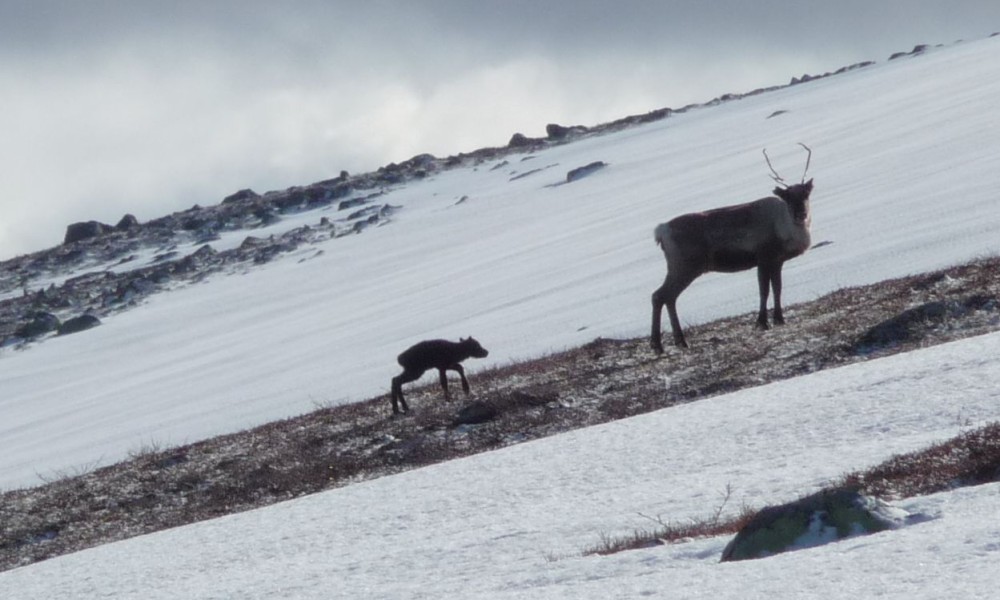Reindeer’s seasonal adaptation: fur, fat and eyes

Arctic seasons are known for their extremes. Variety in temperature and changes in light between summer and winter months are the common environmental circumstances that call for adaptation. With the approach of winter, the reindeer start to put on a lot of body fat and also their coats fill out, in color changing from brown to white. Another characteristic was discovered in 2013 at the University of Tromsø in Norway: also the color of the eyes changes with the season. Golden eyes in summer, blue in winter. As if to match the appearance of the period of the year.
Reindeer eyes change colors
Why? Enhanced night vision is clearly the positive result of this color changing trick and thus a helpful ability to spot predators in the stretched darkness during the long winter’s months. Although this vision is not as clear as that in summer, seeing a blurred shape that might be in search of a meal, pushing the ‘predator=run’ button in the reactions panel, is indisputably a better condition then detecting nothing at all.
How it works:
◊ reindeer have a special tissue in the eye behind the retina, the tapetum lucidum (TL)
◊ this TL can change its color: golden in summer with most light reflected back directly, deep blue in winter with less light reflected out of the eye
◊ as a result there is more retinal sensivity, enhancing the night vision.

Calving grounds, beginning of May
Defence preparedness: a pair of antlers
It all makes sense. Animals that are not predator but prey often do have one or two special effects skills or characteristics that may be helpful to return to a more safe and convenient state. Reindeer have two ways only to defend themselves from being attacked: running away or stabbing the attacker with their antlers. By the way, reindeer are the only deer species where both the males and the females possess antlers, an unique characteristic. Actually using those horns in a fight is not, as a rule, the female’s behaviour. The readiness comes with the mothering instinct. A predator may encounter her, in which case the female will often choose fight over flight when being pregnant. When she has a calf with her that has to be defended, such an emergency case is leaving her with limited options too for the obvious reason that the calf can not get away as quickly as needed.
Searching for food
During the long winters in the Nordic countries, food is scarse. The large, flat hooves serve the mature reindeer as snowshoes, with an added on seasonal change: during autumn and winter the hooves will harden, in this way enabling the animals to search for food through hard crusts of snow and ice. Considering the calves, for the most part the vulnerable segment of a herd, they lack the adaptation of the hooves to a certain degree, because they are still young. Antlers are the useful tools because they facilitate the digging for food in deep snow. Youngsters depend on their mother’s help here.
Migrating herds
It is in the Sami spring-winter season that the reindeer herds will begin the migration to the calving grounds in the mountains. Like the salmons, they return to the same area every year. A wonderful sight it is, smaller and larger groups are walking from the forests uphill until they meet on higher grounds, thousands of reindeer are on the move. Every day counts, an early spring may bring the warmth of the sunlight but also the snow turning into slush, which is an unfavourable travel condition for the reindeer. If the higher grounds have not been reached in time, the calves are born in the foothills of the mountains, with more predators around. Without stepping into the climate changes debate here, the warmer temperatures in recent years are not welcomed by everyone.
Change of the seasons
Right now the snow is melting and new colors signal the arrival of spring. Calves will follow their mothers, picking up the movements of life. After some 45 days they are able to graze and forage, imitating the adults who savour every mouthfull of reindeer moss. This species of lichen with its glow-in-the-dark pale grayish green color is native to arctic regions and is the reindeer’s favorite food. But it is not until the following autumn that the newborns will become independent from their mothers, the time when during the autumn migration the groups become smaller again. It is also the start of the mating season, roughly from late September to early November.
Rangifer tarandus. The arctic environment is their home, the climate adapted life cycle is their pace, having lost the circadian rhythm by force of nature. Which is neither surprising nor unnecessary considering a habitat where deep darkness exists in winter, as well as endless midsummer days. In between, it means long mosquito filled months followed by a splendid autumn before the winterblues are in the reindeer’s eyes again.
Read and see more
- Shifting mirrors: adaptive changes in retinal reflections to winter darkness in Arctic reindeer – Karl-Arne Stokkan et al. – 30 October 2013.
- A comprehensive reindeer fact file can be found on Wildscreen Arkive.
- And beautiful photography by Erika Larsen, a collection titled ‘Sami – Walking with reindeer’.
Photographs by Helena Andersson
Leave a Reply
You must be logged in to post a comment.






2 Comments
What Color Are Reindeer?
August 25, 2022[…] https://treelinetales.com/reindeers-seasonal-adaptation-fur-fat-and-eyes/ […]
What Color Is A Reindeer Fur?
August 28, 2022[…] https://treelinetales.com/reindeers-seasonal-adaptation-fur-fat-and-eyes/ […]